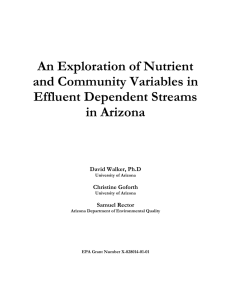Diptera Community Composition and Succession Following Habitat Disturbance by Wildfire Extended Abstract
advertisement
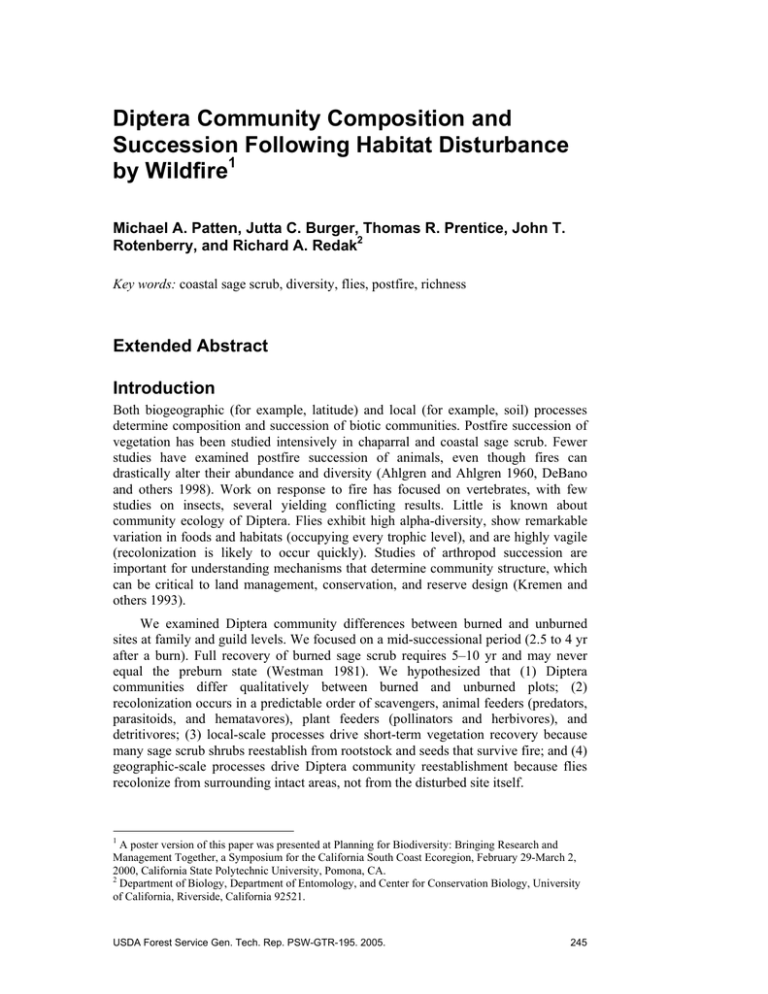
Diptera Community Composition and Succession Following Habitat Disturbance by Wildfire1 Michael A. Patten, Jutta C. Burger, Thomas R. Prentice, John T. Rotenberry, and Richard A. Redak2 Key words: coastal sage scrub, diversity, flies, postfire, richness Extended Abstract Introduction Both biogeographic (for example, latitude) and local (for example, soil) processes determine composition and succession of biotic communities. Postfire succession of vegetation has been studied intensively in chaparral and coastal sage scrub. Fewer studies have examined postfire succession of animals, even though fires can drastically alter their abundance and diversity (Ahlgren and Ahlgren 1960, DeBano and others 1998). Work on response to fire has focused on vertebrates, with few studies on insects, several yielding conflicting results. Little is known about community ecology of Diptera. Flies exhibit high alpha-diversity, show remarkable variation in foods and habitats (occupying every trophic level), and are highly vagile (recolonization is likely to occur quickly). Studies of arthropod succession are important for understanding mechanisms that determine community structure, which can be critical to land management, conservation, and reserve design (Kremen and others 1993). We examined Diptera community differences between burned and unburned sites at family and guild levels. We focused on a mid-successional period (2.5 to 4 yr after a burn). Full recovery of burned sage scrub requires 5–10 yr and may never equal the preburn state (Westman 1981). We hypothesized that (1) Diptera communities differ qualitatively between burned and unburned plots; (2) recolonization occurs in a predictable order of scavengers, animal feeders (predators, parasitoids, and hematavores), plant feeders (pollinators and herbivores), and detritivores; (3) local-scale processes drive short-term vegetation recovery because many sage scrub shrubs reestablish from rootstock and seeds that survive fire; and (4) geographic-scale processes drive Diptera community reestablishment because flies recolonize from surrounding intact areas, not from the disturbed site itself. 1 A poster version of this paper was presented at Planning for Biodiversity: Bringing Research and Management Together, a Symposium for the California South Coast Ecoregion, February 29-March 2, 2000, California State Polytechnic University, Pomona, CA. 2 Department of Biology, Department of Entomology, and Center for Conservation Biology, University of California, Riverside, California 92521. USDA Forest Service Gen. Tech. Rep. PSW-GTR-195. 2005. 245 Poster session—Diptera Succession After Wildfire—Patten and others Methods We sampled 12 burned and 12 unburned plots (50-m diameter) in coastal sage scrub at the Southwestern Riverside County Multispecies Reserve at Lake Skinner, California, following a 1993 fire. We quantified vegetation using standard pointintercept and line-transect methods. We sampled arthropods at 3-month intervals from March 1996 to December 1997 using malaise traps (1 trap/plot/sampling period), vacuums (5 transects/plot/period), and pitfalls (7 traps/plot/period). Specimens were identified to family and classified into foraging guilds. Fluctuations in family richness over time did not differ between unburned and burned plots (profile analysis; P > 0.15, n = 8 samples), so data were pooled by site across sampling periods. Differences between unburned and burned plots in vegetation and Diptera were tested with MANOVA (multiple analysis of variance). The association between vegetation and Diptera abundance was determined with Mantel tests. The pattern of Diptera recolonization was inferred using isotonic regression of mean percent correct classification from discriminant function analyses (DFA) for each family (n = 36). Means and SEs were calculated by guild (n = 7). Our H0 was discrimination of plots is equal across guilds; our ordered expectation HA was detritivores ≥ pollinators ≈ herbivores ≥ predators ≈ parasitoids ≈ hematavores ≥ scavengers, with at least one strict inequality. Results A total of 12,437 individual flies in 46 families were collected, with Chironomidae by far the most abundant family collected. Because of potential swamping, malaisecollected Chironomidae were excluded from analyses. The next best represented families were Cecidomyiidae, Anthomyiidae, Tipulidae, Empididae, Chloropidae, and Phoridae. Burned and unburned plots differed significantly in vegetation structure and composition (MANOVA, Wilks' Λ = 0.12, P < 0.01), but community composition of Diptera did not differ between plots at the level of family (Wilks' Λ = 0.07, P > 0.5) or guild (Wilks' Λ = 0.48, P > 0.05). Nevertheless, there was a strong association between vegetation and Diptera families (Mantel standardized r = 0.28, P < 0.02) and guilds (r = 0.22, P < 0.05). Scavengers occupied burned sites with roughly equal frequency as unburned, so their abundance was a poor discriminator of plot type; detritivores were much more abundant on unburned sites and were better discriminators of plot type (table 1). Our data supported the recolonization sequence we predicted for Diptera guilds (S = 6.38, P < 0.05), underscoring the unequal (but predictable) recovery rates. Discussion Dipteran communities recovered quickly from impacts of fire, consistent with previous studies of overall insect abundance (Force 1981, Moya-Raygoza 1995) and Diptera in particular (Delettre 1994). Burned sites were indistinguishable from unburned sites in overall community, with common generalist feeders and scavengers equally represented; Lomonaco and Almeida (1995) reported the same pattern. Similarity across plots resulted from similarity in abundance of dominant fly 246 USDA Forest Service Gen. Tech. Rep. PSW-GTR-195. 2005. Poster session—Diptera Succession After Wildfire—Patten and others families; presence/absence data may yield different interpretations of community equality (Patten and Rotenberry 1998) but an ordination with such data produced comparable results in our case. We detected a distinct, predictable pattern of guild recolonization following a successional sequence from scavengers to animal-feeders to plant-feeders to detritivores. Our results support the hypothesis that the key to community structure is extrinsic biogeography rather than intrinsic local processes (Cornell and Lawton 1992). Local processes play an important role (abundances of some families differed markedly). These processes probably include microhabitat (Tolbert 1975) and relative amounts of shrubs and herbs (Bährmann 1984), which affect guilds (and thus families) differently. Table 1—Percent correct classification of burned and unburned plots using discriminant function analysis. Means were calculated across families within each guild (thus the different sample sizes for each guild). The ordered expectation of isotonic decrease is significant (0.01 < P < 0.05). Diptera guild Sample size Mean % (± SE) correctly classified detritivore pollinator + herbivore predator + parasitoid + hematavore scavenger 60.1% ± 2.6 54.2% ± 3.0 50.4% ± 4.7 45.1% ± 6.8 per guild (ni) 14 9 12 11 Acknowledgments M.L. Buffington, K.A. Campbell, T. Hosch, E.E. Porter, and C. Slotnik assisted in the field and lab. C.E. Dunning and the Rotenberry lab provided helpful criticism of this presentation. The Metropolitan Water District of Southern California (agreement no. 4602) funded this work. References Ahlgren, I.F.; Ahlgren, C.E. 1960. Ecological effects of forest fires. Botanical Review 26: 483-533. Bährmann, R. 1984. Die Zweiflugler der Kraut—und Strauchschicht des Leutratals bei Jena (Thüringen)—ein ökofaunistischer Vergleich. Zoologische Jahrbücher Abteilung Systematika 111: 175-217. Cornell, H.V.; Lawton, J.H. 1992. Species interactions, local and regional processes, and limits to the richness of ecological communities: A theoretical perspective. Journal of Animal Ecology 61: 1-12. DeBano, L.F.; Neary, D.G.; Ffolliott, P.F. 1998. Fire's effects on ecosystems. New York: John Wiley & Sons; 333 p. Delettre, Y.R. 1994. Fire disturbance of a chironomid (Diptera) community on heathlands. Journal of Applied Ecology 31: 560-570. Force, D.C. 1981. Postfire insect succession in southern California chaparral. American Naturalist 117: 575-582. USDA Forest Service Gen. Tech. Rep. PSW-GTR-195. 2005. 247 Poster session—Diptera Succession After Wildfire—Patten and others Kremen, C.; Colwell, R.K.; Erwin, T.L.; Murphy, D.D.; Noss, R.F.; Sanjayan, M.A. 1993. Terrestrial arthropod assemblages: Their use in conservation planning. Conservation Biology 7: 796-808. Lomonaco, C.; Almeida, J.R.D. 1995. Muscoid Diptera community structure of Jacarepagua sand dunes, Rio de Janeiro, Brazil. Revista Brasileira de Entomologia 39: 891-896. Moya-Raygoza, G. 1995. Fire effects on insects associated with the gamagrass Tripsacum dactyloides in Mexico. Annals of the Entomological Society of America 88: 343-440. Patten, M.A.; Rotenberry, J.T. 1998. Post-disturbance changes in a desert breeding bird community. Journal of Field Ornithology 69: 614-625. Tolbert, W.W. 1975. The effects of slope exposure on arthropod distribution patterns. American Midland Naturalist 94: 38-53. Westman, W.E. 1981. Diversity relations and succession in California coastal sage scrub. Ecology 62: 170-184. 248 USDA Forest Service Gen. Tech. Rep. PSW-GTR-195. 2005.
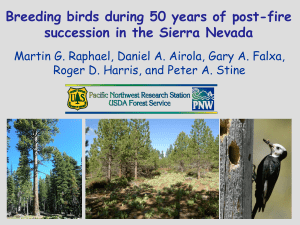


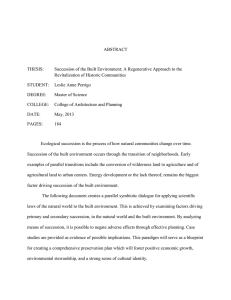
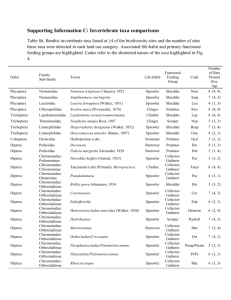

![Observations of Arthropod Populations Following the La Mesa Fire of 197']1 F.](http://s2.studylib.net/store/data/011866263_1-edbdb5f2e2ac67487d4079dde121a29f-300x300.png)
